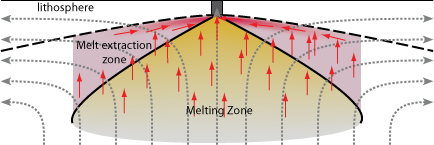Montesi
Laurent G.J. Montesi1, Laura B. Hebert1, Wenlu Zhu1, Mark D. Behn2, Patricia M. Gregg3, Richard F. Katz4
- University of Maryland, Department of Geology, College Park, MD 20742
- Woods Hole Oceanographic Institution, Department of Geology and Geophysics, Woods Hole, MA 02543
- Oregon State University, Department of Geosciences, Corvallis, OR 97331
- University of Oxford, Department of Earth Sciences, Oxford, OX1 3PR, UK
The global geodynamical significance of oceanic spreading centers lies in the fact that they accommodate plate divergence and the vast majority of melt production on Earth. These processes are linked, as melt generation occurs as a result of decompression of the mantle as it rises underneath the spreading center, while melt likely weakens the plate boundary to enable localized divergence. Three fundamental questions related to melt generation and extraction have been the focus of geodynamic studies for decades:
- Is mantle upwelling essentially passive or active?
- How does melt focus toward the spreading center?
- How does along-strike segmentation develop?
- Multidisciplinary data collected at oceanic spreading centers and laboratory studies have provided new constraints to these questions and motivate the development of integrative geodynamic models of spreading centers.
Tomographic evidence for low residual melt fraction underneath spreading centers and U-series disequilibrium imply efficient melt extraction. Permeability estimates of partially molten aggregates and the possibility of developing localized melt channels, tested by the presence of chemical disequilibrium between peridotites and basalts, permit rapid melt extraction. Rapid melt migration is little influenced by the trajectory of mantle and is expected to follow pressure gradients instead, which, for a mantle viscosity of 1019 Pa s, are clearly dominated by melt buoyancy. Thus, melt migration in the melt generation zone underneath the axis is principally vertical. The low residual porosity implies little density difference in the mantle, and therefore principally passive upwelling. However, porosity-driven convection appears necessary to capture the asymmetry of melting in regions of ridge migration, implying viscosities less than 1018 Pa s (Question 1).
The inference that melt trajectory at depth is essentially vertical cannot be valid near the surface, as it implies little to no melt focusing toward and along the axis. Sparks and Parmentier (1991) proposed that as melt enters the thermal boundary layer at the base of the plate and crystallizes, it forms a permeability barrier. Then, melt migrates along this boundary to collect at the ridge axis. This concept has now been applied to geodynamic models of several segmented spreading centers and can explain crustal thickness variations from ultraslow to ultrafast ridges. Further evidence for this focusing mechanism is provided by seismic evidence for gabbro bodies in the lower crust at several Ridge2000 focus sites and refertilization of mantle peridotites (Question 2).
This melt migration scenario opens the door to addressing Question 3. If focusing along the permeability leads to focusing of melt at certain points along the ridge axis, localized heat input to the ridge can modify the shape of the permeability barrier. Localized magma flux is likely associate to a high density of intrusive features, weakening the axis and facilitating spreading. These two consequences of melt migrations would have the effect of thinning the TBL and increasing melt focusing. Thus, the coupled melt migration and thermal structure system features several positive feedback processes that may result in a segmented magmatic system along the axis. The identification and characterization of this feedback system necessitates the integration of petrological, geophysical, and geodynamical approaches.

